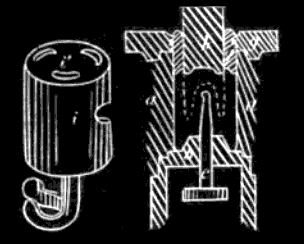[Trade Journal]
Publication: Greenough's American Polytechnic Journal
Washington, DC, United States
vol. III, no. 1, p. 292
No. 11,515. William Brooke, of Jersey City, N. J. — Improvement in Glass
Moulds. Dated August 15, 1854.
|
This improvement consists in securing a shoulder g' into the cap g. This shoulder acts as a plunger on the glass within the mould, forcing it down. The cap, g, with its shoulder, having been introduced, the plunger, h, is next put in, which pressing upon the glass, causes the latter to fill up every crevice of the mould. If the operator did not put enough glass into the mould to form the insulator solid, by the use of this improved cap, the plunger forces the glass to assume on its exterior the exact dimensions of the mould, through the interior, or middle parts of the insulator would not be quite filled out, which is a matter of no consequence, it being desirable to produce the insulators with their exterior lengths and diameters all of exact sizes.
In using this improvement, the telegraph hook, c, is put within the hook-holder b, and the latter placed inside the mould a, in order to cast the glass and hook together. The hook-holder and mould are closed within their receptacles, and the operator cuts off such a quantity of the metal as he judges will be sufficient to form an insulator i, and drops it into the mould. The cap g, is then laid on, and the plunger h, brought down by means of a press, whereby a proper degree of force is applied to the glass-metal, which causes the glass to fill up the cavities of the mould.
"I claim the shoulder g', when used in combination with the cap-plate g, and plunger h, in the manner, and for the purposes set forth."

